Los principiantes a menudo nos preguntan sobre cómo pasar sus sitios web a SSL o HTTPS. Los términos pueden sonar demasiado técnicos, pero en realidad es muy fácil de hacer.
HTTPS en la URL de un sitio web significa que utiliza un protocolo seguro de transferencia de datos mediante la instalación de un certificado SSL. Esto es importante porque la mayoría de los navegadores modernos muestran advertencias para los sitios web que no utilizan HTTPS.
Por suerte, la mayoría de las empresas de alojamiento fiables y WordPress hacen que sea muy fácil proteger su sitio web.
En este artículo, le mostraremos cómo mover su WordPress de HTTP a HTTPS añadiendo un certificado SSL. No te preocupes si no sabes lo que es SSL o HTTPS. También se lo explicaremos.
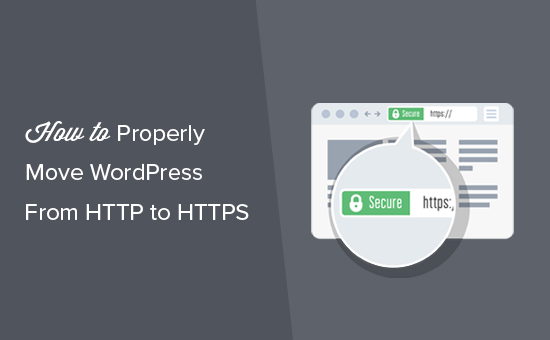
He aquí un breve resumen de los temas que trataremos en este artículo:
- What Is HTTPS?
- Why Do You Need HTTPS and SSL?
- Requirements for Using HTTPS/SSL on a WordPress Site
- Setting Up WordPress to Use SSL and HTTPS
- Method 1: Setup SSL/HTTPS in WordPress Using a Plugin
- Method 2: Set Up SSL/HTTPS in WordPress Manually
- Submit Your HTTPS Site to Google Search Console
- Bonus Resources
- Video Tutorial
¿Qué es HTTPS?
HTTPS, o HTTP seguro, es un método de encriptación que asegura la conexión entre el navegador de un usuario y su servidor. Esta seguridad añadida hace que sea mucho más difícil para los hackers interceptar los datos que se transfieren.
Todos los días, la gente comparte datos personales con sitios web, ya sea para realizar compras o simplemente para iniciar sesión. Hemos visto de primera mano lo crucial que es proteger este tipo de intercambio de datos.
Para garantizar la seguridad de los datos, es necesario establecer una conexión segura.
Aquí es donde SSL y HTTPS entran en juego.
Cada sitio web recibe un certificado SSL único para su identificación. Si un servidor intenta utilizar HTTPS sin un certificado válido o si el certificado no coincide, la mayoría de los navegadores modernos avisarán a los usuarios y les aconsejarán que no continúen.
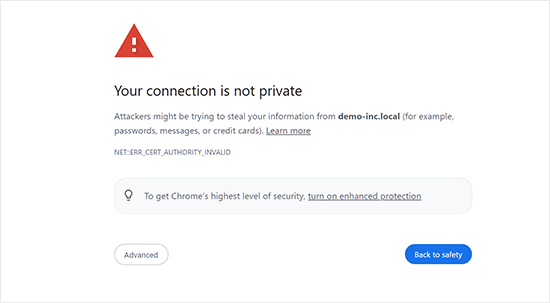
Ahora, usted podría preguntarse por qué es necesario mover su sitio de WordPress de HTTP a HTTPS, especialmente si se trata de un simple blog o sitio web de pequeñas empresas que no procesan pagos.
¿Por qué necesita HTTPS y SSL?
Ya en 2018, Google anunció una iniciativa para impulsar la seguridad web instando a los propietarios de sitios a cambiar de HTTP a HTTPS. Para apoyar este movimiento, su navegador Chrome comenzó a marcar todos los sitios web sin un certificado SSL como “No seguros”.
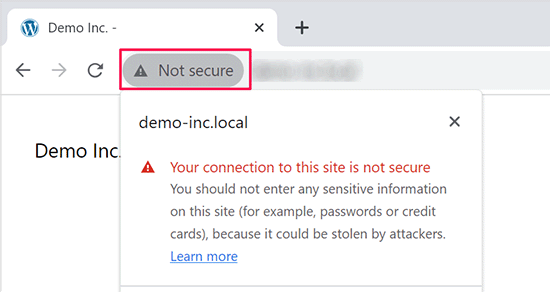
Google también mencionó que los sitios con SSL recibirían ventajas de SEO y podrían alcanzar clasificaciones de búsqueda más altas que los sitios no seguros. Este anuncio empujó a muchos propietarios de sitios a cambiar a HTTPS.
Cuando se lanzó la advertencia “No seguro”, Chrome empezó a marcar los sitios HTTP. Por ejemplo, visitar un sitio HTTP en modo incógnito o rellenar un formulario de contacto en un sitio HTTP activa la advertencia, marcándolo como inseguro.
Cuando los visitantes ven esta advertencia, pueden llevarse una impresión negativa de su sitio o negocio.
Por este motivo, todos los sitios web deben realizar la transición a HTTPS e instalar SSL lo antes posible.
Además, SSL es imprescindible si desea aceptar pagos en línea en su sitio de comercio electrónico.
Los proveedores de pago como Stripe, PayPal Pro y Authorize.Net requieren una conexión de pago segura.
Nos aseguramos de que nuestros propios sitios utilicen SSL, incluyendo WPBeginner, OptinMonster, WPForms y MonsterInsights.
Requisitos para utilizar HTTPS/SSL en un sitio de WordPress
Los requisitos para utilizar SSL en WordPress no son muy elevados. Basta con adquirir un certificado SSL, y puede que ya lo tengas de forma gratuita.
Las mejores empresas de alojamiento de WordPress ofrecen certificados SSL gratuitos a todos sus usuarios:
Para obtener más información, consulte nuestra guía sobre cómo obtener un certificado SSL gratuito para su sitio web en WordPress.
Si su empresa de alojamiento no ofrece un certificado SSL gratuito, tendrá que adquirir uno.
Recomendamos Domain.com porque ofrece la mejor oferta de certificados SSL normales y comodín.
Al comprarles un certificado SSL, también obtendrá un sello TrustLogo para su sitio web. Cada certificado SSL tiene una garantía de seguridad mínima de 10.000 dólares. Los precios empiezan en 33 $ anuales y los certificados SSL se renuevan automáticamente.
Una vez que haya adquirido un certificado SSL, deberá solicitar a su proveedor de alojamiento que se lo instale.
¿Necesita ayuda para configurar SSL y pasar a HTTPS?
Si no tiene tiempo de configurar SSL, nuestro servicioPremium WordPress Support está aquí para ayudarle. Podemos encargarnos de todo el proceso por ti, garantizando que tu sitio sea seguro y esté listo para recibir visitas.
- Tasa única
- Plazos de entrega rápidos
- Disponible 24 horas al día, 7 días a la semana
Puede estar tranquilo sabiendo que su sitio está en manos expertas. Póngase en contacto con nosotros hoy mismo para una instalación SSL y migración HTTPS sin problemas.
Establecer el uso de SSL y HTTPS en WordPress
Después de activar un certificado SSL para su nombre de dominio, tendrá que configurar WordPress para utilizar los protocolos SSL y HTTP en su sitio web.
Le mostraremos dos métodos para hacerlo, y podrá elegir el que mejor se adapte a sus necesidades.
Método 1: Configurar SSL/HTTPS en WordPress mediante un plugin
Este método es más sencillo y se recomienda a los principiantes.
En primer lugar, debe instalar y activar el plugin Really Simple SSL. Para más detalles, consulta nuestra guía paso a paso sobre cómo instalar un plugin de WordPress.
Tras la activación, debe visitar la página Configuración ” SSL. El plugin detectará automáticamente su certificado SSL y configurará su sitio WordPress para utilizar HTTPS.
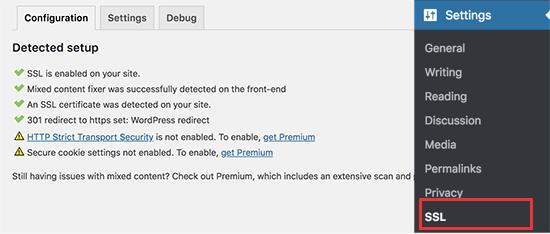
El plugin se encargará de todo, incluidos los errores de contenido mixto. Esto es lo que hace el plugin entre bastidores:
- Marcar / comprobar certificado SSL
- Establecer WordPress para usar https en URLs
- Establecer redireccionamientos de HTTP a HTTPS
- Busque URLs en su contenido que todavía se estén cargando desde fuentes HTTP inseguras e intente arreglarlas.
Nota: El plugin intenta solucionar los errores de contenido mixto utilizando una técnica de almacenamiento en búfer de salida. Esto puede tener un impacto negativo en el rendimiento, ya que reemplaza el contenido del sitio a medida que se carga la página. Este impacto sólo se ve en la primera carga de la página, y debería ser mínimo si está utilizando un plugin de almacenamiento en caché.
Aunque el plugin dice que puedes mantener SSL y desactivar el plugin de forma segura, no es 100% cierto. Tendrás que dejar el plugin activo en todo momento porque desactivarlo traerá de vuelta errores de contenido mixto. Vea nuestra revisión de Really Simple SSL para más detalles.
Método 2: Establecer SSL/HTTPS en WordPress manualmente
Este método requiere que diagnostiques los problemas manualmente y edites los archivos de WordPress. Sin embargo, es una solución permanente y de mayor rendimiento, y la estamos utilizando en WPBeginner.
Si este método le resulta difícil, debería contratar a un desarrollador de WordPress o utilizar el primer método en su lugar.
Es posible que tenga que editar el tema de WordPress y los archivos de código como parte de este método. Si no lo has hecho antes, consulta nuestra guía sobre cómo copiar y pegar fragmentos de código en WordPress.
En primer lugar, debe visitar la página Configuración ” General. Desde aquí, debe actualizar los campos de dirección URL de WordPress y del sitio sustituyendo http por https.
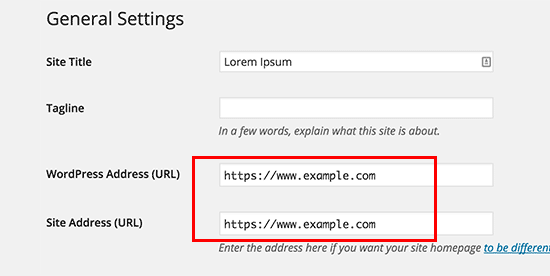
No olvides hacer clic en el botón “Guardar cambios” para establecer los ajustes.
Una vez guardados los ajustes, WordPress le desconectará y le pedirá que vuelva a conectarse.
A continuación, debe establecer los redireccionamientos de WordPress de HTTP a HTTPS añadiendo el siguiente código a su archivo .htaccess:
<IfModule mod_rewrite.c>
RewriteEngine On
RewriteCond %{HTTPS} off
RewriteRule ^(.*)$ https://%{HTTP_HOST}%{REQUEST_URI} [L,R=301]
</IfModule>
Si utiliza servidores NGINX, tendrá que añadir el siguiente código para redirigir de HTTP a HTTPS en su archivo de configuración:
server {
listen 80;
server_name example.com www.example.com;
return 301 https://example.com$request_uri;
}
No olvide sustituir ejemplo.com por su nombre de dominio.
Siguiendo estos pasos, evitará el error de WordPress HTTPS not working porque ahora WordPress cargará todo su sitio web usando HTTPS.
Si desea forzar SSL y HTTPS en su área de administrador de WordPress o páginas de acceso, necesita configurar SSL en el archivo wp-config.php.
Añada el siguiente código encima de la línea “¡Eso es todo, deje de editar!” en su archivo wp-config.php:
define('FORCE_SSL_ADMIN', true);
Esta línea permite a WordPress forzar SSL / HTTPs en el área de administrador de WordPress. También funciona en redes multisitio de WordPress.
Una vez hecho esto, su sitio web estará totalmente establecido para utilizar SSL / HTTPS, pero seguirá encontrando errores de contenido mixto.
Estos errores son causados por fuentes (imágenes, scripts u hojas de estilos) que todavía se cargan utilizando el protocolo HTTP inseguro en las URL. Si ese es el caso, entonces no podrá ver un icono de candado seguro en la barra de direcciones de su sitio web.

Muchos navegadores modernos bloquean automáticamente los scripts y recursos no seguros.
Es posible que vea un icono de candado pero con un aviso acerca de ello en la barra de direcciones de su navegador.
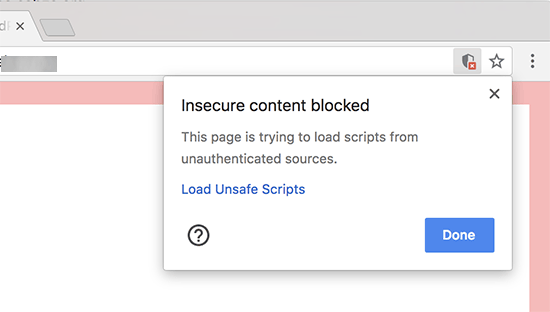
Puede averiguar qué contenidos se sirven a través de un protocolo inseguro utilizando la herramienta Inspeccionar.
El error de contenido mixto se mostrará como una advertencia en la consola con detalles para cada elemento / artículo de contenido mixto.

Observará que la mayoría de las URL son imágenes, iframes y galerías de imágenes, mientras que algunas son scripts y hojas de estilos cargadas por sus plugins y temas de WordPress.
Corrección de contenido mixto en la base de datos de WordPress
La mayoría de las URL incorrectas serán imágenes, archivos, incrustaciones y otros datos almacenados en la base de datos de WordPress. Vamos a corregirlos primero.
Lo mejor sería que encontrara en la base de datos todas las menciones de la URL de su antiguo sitio web que empiecen por HTTP y las sustituyera por la URL de su nuevo sitio web que empiece por HTTPS.
Puedes hacerlo fácilmente instalando y activando el plugin Search & Replace Everything. Para más detalles, consulta nuestra guía paso a paso sobre cómo instalar un plugin de WordPress.
Una vez activado, debe visitar la página Herramientas ” WP Search & Replace. En el campo ‘Buscar’, tienes que añadir la URL de tu sitio web con http. A continuación, añada la URL de su sitio web con https en el campo “Reemplazar”.

Debajo verá todas las tablas de su base de datos de WordPress.
Debe seleccionarlos todos para realizar una comprobación exhaustiva.

A continuación, haz clic en el botón “Vista previa de Buscar y reemplazar” para ver todos los cambios que realizará el complemento.
Por último, haga clic en el botón “Reemplazar todo”.
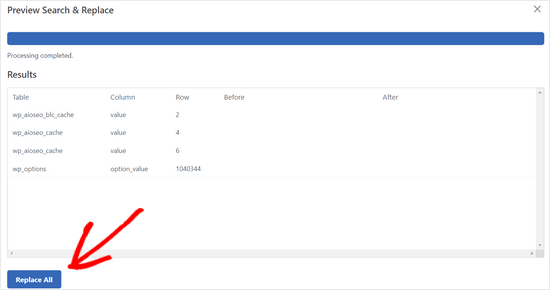
El plugin buscará en su base de datos de WordPress las URLs que empiecen por http y las sustituirá por URLs https seguras. Puede tardar un poco, dependiendo del tamaño de la base de datos de WordPress.
Corrección de errores de contenido mixto en el tema de WordPress
Otro culpable común de los errores de contenido mixto es tu tema de WordPress. Cualquier tema de WordPress decente que siga los estándares de código de WordPress no causará este problema / conflicto / incidencia.
En primer lugar, tendrá que utilizar la herramienta Inspeccionar de su navegador para encontrar los recursos y saber desde dónde se están cargando.

Después, tendrá que encontrarlos en su tema de WordPress y sustituirlos por https. Esto será un poco difícil para la mayoría de los principiantes, ya que no será capaz de ver qué archivos de tema contienen estas URL.
Corrección de errores de contenido mixto causados por plugins
Algunos recursos de contenido mixto serán cargados por plugins de WordPress. Cualquier plugin de WordPress que siga los estándares de código de WordPress no causará errores de contenido mixto.
No recomendamos editar los archivos de los plugins de WordPress. En su lugar, debe ponerse en contacto con el autor del plugin y hacérselo saber. Si no responden o no se ha podido corregir el problema, busque una alternativa adecuada.
Nota: Si, por alguna razón, sigue encontrando un error de contenido mixto, le recomendamos que utilice temporalmente el plugin Really Simple SSL para que sus usuarios no se vean afectados mientras corrige el problema en un sitio web de prueba o contrata a un desarrollador.
Envíe su sitio HTTPS a Google Search Console
Los motores de búsqueda como Google consideran que https y http son dos sitios web diferentes. Para evitar cualquier problema / conflicto / incidencia de SEO, deberá informar a Google de que su sitio web se ha trasladado.
Para ello, sólo tiene que acceder a su cuenta de Google Search Console y hacer clic en el botón “Añadir propiedad”.

Aparecerá una ventana emergente en la que deberá añadir la nueva dirección https de su sitio web.
Existen dos métodos de verificación de sitios: nombre de dominio o prefijo URL. Recomendamos el método del prefijo URL porque es más flexible.
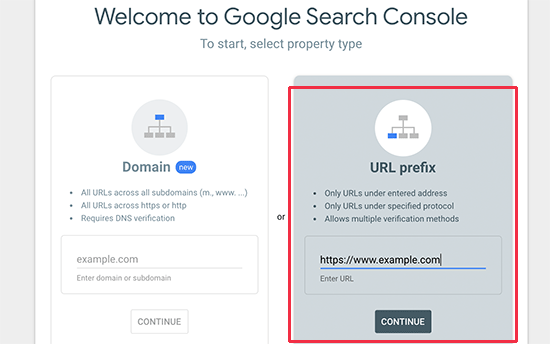
A continuación, Google le pedirá que verifique la propiedad de su sitio web.
Hay varias formas de hacerlo. Seleccione cualquier método y obtendrá instrucciones para verificar su sitio. Le recomendamos que utilice el método de etiquetas HTML.
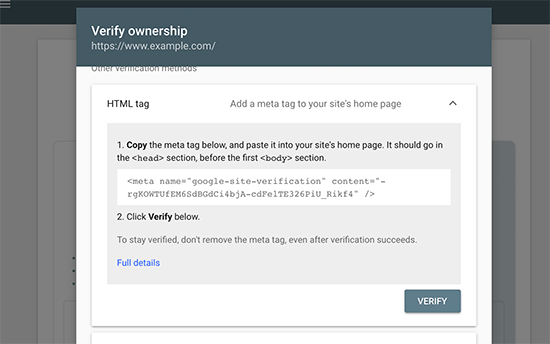
Ahora verá un fragmento de código HTML que deberá añadir a la sección encabezado de su sitio web WordPress.
Añadir código de verificación de Search Console usando All in One SEO
En primer lugar, instale y active el plugin All in One SEO para WordPress. Para más detalles, consulte nuestro tutorial sobre cómo instalar un plugin de WordPress.
Nota: También existe una versión gratuita de All in One SEO que puedes probar.
Una vez activado, ve a la página Todo en uno SEO ” Configuración general y haz clic en Google Search Console.

A continuación, debe añadir el código de verificación que copió anteriormente del sitio web de Google Search Console.
No olvides hacer clic en el botón “Guardar cambios” para establecer los ajustes.
A continuación, vuelve a la pestaña Google Search Console y haz clic en el botón “Verificar”.

Una vez verificado su sitio, Google mostrará aquí los informes de su consola de búsqueda.
También debe asegurarse de que tanto la versión https como la http están añadidas a su Search Console.
Esto indica a Google que desea que la versión https de su sitio web sea tratada como la versión principal. Combinado con los redireccionamientos 301 configurados anteriormente, Google transferirá sus clasificaciones de búsqueda a la versión https de su sitio web, y lo más probable es que vea mejoras en sus clasificaciones de búsqueda.
Recursos adicionales
A continuación se indican algunos recursos adicionales que pueden ayudarle a solucionar problemas comunes de WordPress por su cuenta y a aprender más sobre WordPress:
- Cómo corregir problemas comunes de SSL en WordPress (Guía para principiantes)
- Los errores más comunes de WordPress y cómo corregirlos
- TLS vs SSL: ¿Qué protocolo debería utilizar para WordPress?
- Cómo corregir el error de conexión segura en WordPress
Tutorial en vídeo
Esperamos que este artículo te haya ayudado a añadir HTTPS y SSL en WordPress. Puede que también quieras ver nuestra guía definitiva de seguridad en WordPress con instrucciones paso a paso para mantener tu sitio WordPress seguro o cómo renovar tu certificado SSL.
If you liked this article, then please subscribe to our YouTube Channel for WordPress video tutorials. You can also find us on Twitter and Facebook.





Raul
Hi,
I’m in a predicament due to lack of knowledge and Google. My website is currently ranked # 2 in Google for a particular organic keyword. I ordered a SSL from my hosting company and I received confirmation that the SSL is ready to be used. I would like to use the SSL on every page in my site including the shopping cart but I don’t want to lose the #2 ranking in Google by not converting to SSL properly. Your advice will be appreciated.
Raul
Jonathon Fowler
Hi there,
Great article. One question, I read that using a wildcard redirect will have a negative impact on SEO – is this correct? The articel says ranking will drop using a wildcard redirect.
I have thousands if images on my site using http in the url…using yur redirect would direct all images to the new https?
Thanks !
WPBeginner Support
No, the whole purpose of redirects is to help with SEO and avoid negative impact of changed URLs. This is the method recommended by search engines themselves.
Admin
dylan
Hi,
I love your site – lots of good stuff here.
I’m wondering if you can recommend a wordpress security plug-in that you know for sure plays friendly (without too much hassle) with full site SSL / HTTPS.
My site is covered already (every page) but I’m worried about installing a plug-in that may interfere.
Any suggestions would be much appreciated.
Cheers
WPBeginner Support
We use Sucuri on WPBeginner and all other websites that we manage.
Admin
turan
Thank you very much everything solved by adding above code to .htaccess file
Joe
Will changing the Site URL in WordPress to “HTTPS” auto redirect any HTTP requests?
We don’t need htaccess rewrites if the SITE URL is HTTPS?
Cristi Scutaru
Great post, it helped me switch my WordPress site to SSL in just a few minutes!
Great site as well, congrats for such a valuable content. I found myself often googling for some WordPress related answers for the past few days, and your pages came on top frequently, with clear and concise solutions.
WPBeginner Support
Thanks, glad you found it helpful.
Admin
Piet
When only switching the WP backend to SSL, the next challenge is how to show featured images in the backend? These are loaded via http instead of https and as such do not show in the WP backend anymore.
Is there a way to load them from https for the backend only or do I just have to accept the fact that I will not be able to see them (in the backend)?
Tushar
Good article. Why don’t you use https on WPBegineer?
WPBeginner Support
We don’t use it right now but may be in future.
Admin
Yuvraj Khavad
Hi Team wpbeginner,
Thanks for this post. You save my time.
Keep Good Work.
Thanks
Yuvraj R K.
Logan
Thanks for this great guide to setting up https. Was using the plugin your mentioned for a long time but it caused problems with my site so I only used it to secure my admin panel. Now I can cover my entire site.
Felix Figueroa
The .htaccess edit broke my site with the “ERR_TOO_MANY_REDIRECTS” message. Tried suggestions detailed in this post. After disabling all plugins i get a 500 Server Error. Thanks, my site is completely broken now.
Eivind F Skjellum
Thanks, very helpful. Got my ssl working thanks to you!
Eivind
beamkiller
Dear wpBeginner,
I have made the modifications in htaccess and Options too but I got error in Chrome:
ERR_TOO_MANY_REDIRECTS
So my page is not secured with SSL, on Checkout and My-Account it is working with WooCommerce. But I cannot get to work it on the whole WP installation.
MMPrint
Hope this helps:
Uncheck the WooCommerce “Un-force HTTPS when leaving the checkout” setting.
The htaccess if forcing https but then woocommerce forces http so they just go back and forth in a loop.
Chetan
Hi MMPrint
I can give thousand thumbs up to your answer. This has solved my issue which i was living with since the last 10 days. No matter what i tried in the .htaccess file the site wasnt showing up. I also played with deactivating the plugins etc etc. Finally it was woocommerce which was the culprit.
Thanks a lot man !
Cheers
Chetan
Kevin Verlinden
I like this site the information is very useful and comprehensive. It has helped me already a lot of times.
Austin
Hey – any reason SSL is not being used on Optinmonster etc like mentioned in the article?
WPBeginner Support
SSL is used on OptinMonster website when users login or signup.
Admin
Austin
“We already use SSL for our eCommerce sites like OptinMonster, Soliloquy, and Envira Gallery.”
I took this to mean all of the pages – wondering if that was the case and now for some reason it has been reverted to non-SSL?
Thanks!
Armando Landois
I followed this guide and now my domain is working at
George
I tried this plugin and it broke my site. Uninstalled in immediately. I still need what this plugin offered, which is https on some pages, but not the whole site. Is there any other plugin (other than this one, which hasn’t been updated in over two years) that can do this?
Patrick
The free version of iThemes Security will take care of this for you
Celeste
What do you mean, Patrick, that iThemes Security will take care of this. I just went to their website and it seems like a good plugin for enhanced security. But I didn’t see any reference to SSL or setting up specific pages to use SSL only.
Octavio Cestari
I did the installation of a plugin which forced all the site enter https, now I can no longer access the site or the wordpress dashboard, how do I reverse the process?
Drew
I just added the code using your .htaccess solution. Worked perfectly and exactly as described. A big thank you!
michael s
You say all you need to do is buy a certificate, but my hosting service requires a static IP address also which is WAY more expensive than a basic certificate. My service wants $4/month for static IP.
DJ
HELP!
I did this change and now I can’t access my site through WP-ADMIN
It is stating my site is down. I don;t have an .htaccess file in my files. I have set FileZilla to show hidden files and cannot find it. Can you help me get back into my site?
Thanks.
WPBeginner Support
First try to deactivate all your plugins this should resolve your issue, but if it doesn’t then see our guide
Admin
DJ
I cannot get in to deactivate any plugins.
DJ
What Guide?
DJ
OK, added the htaccess file and added the code you have above but I still cannot get in.
Any ideas? All I’m seeing is a message saying my site does not exist.
DJ
David Coombes
DJ
Not sure if you are still having an issue but if you google ‘a plugin broke my site’ or something similar then there’s some good answers – basically it involved removing the plugins folder which should get your site back then reactivating the plugins one by one.
Hope it helps – it’s frustrating when a site goes down.
Sasha
I used the .htaccess method and got this error:
“The page isn’t redirecting properly
Firefox has detected that the server is redirecting the request for this address in a way that will never complete.
This problem can sometimes be caused by disabling or refusing to accept cookies.”
Any one has an idea?
thanks
Mike S
I added the code into the .htaccess and I got the following issue:
The page isn’t redirecting properly
Firefox has detected that the server is redirecting the request for this address in a way that will never complete.
This problem can sometimes be caused by disabling or refusing to accept cookies.
Marych
PLEASE HELP
I didn t get a certificate but just went to settings > General and replaced http by https .
after updating I can t access to my wordpress url and the message ‘ Your connection is not private
Attackers might be trying to steal your information from etlco.com.sa (for example, passwords, messages, or credit cards). ‘ is displayed .
Any solution , please help me
Andron
You need to get a certificate in order for it to work. When you request a page over https, it starts a conversation between your browser and the server in which the server validates its identity as the correct site. That validation occurs by sending a trusted certificate to your browser. If a certificate doesn’t exist, your browser will give you that “connection is not private” warning. It’s done to protect you from sites that aren’t who they claim to be.
Namecheap offers basic SSL certificates for $9 a year, and there are plenty of other options. If you can wait, look into LetsEncrypt.org — they’ll be offering free ones starting this September, I think.
sewe herbert
Hi Marych, just had that same problem, but managed to fix it; here is how
use an FTP Program, alocate the wp-config.php
then put this just after (define(‘ABSPATH’, dirname(__FILE__) . ‘/’);)
define(‘WP_HOME’,’http://yoursite.com’);
define(‘WP_SITEURL’,’http://yoursite.com’);
then save and re-upload the wp-config.php file
Then all is well
Gary Morrison
We have did like you said .. and not we are locked out of the dashboard and any page we go to on front end will not display only home page works.
Thank you for your time ..
P.S. and now my images are not showing up…
WPBeginner Support
Please retry all the steps in the article again. If the problem persists contact your web hosting service provider.
Admin
Gary Morrison
There was a problem on Hosting side with the migration to SSL server..
All is good TY
Tom L
Thank you very much for your support. I was able to install the plugin and have my site with all pages https without any adjustments.
Perfect instructions.
Tecnologia Geek
nice..is working now..how i make this to show the green bar?
Tecnologia Geek
can i have some help here.. i dit all this step but..the site look diferent and i cant login to admin..
Maarten
It is worth mentioning this technique breaks WooCommerce downloads. It will end in a 403 access denied for forced download or x-sendfile downloadable products.
Matthew
Thanks for the excellent article.
I was under the impression that installing an SSL certificate was as simple as you have indicated… however, when I installed mine it appears to confused (and completely broken) my site. I am being told that some parts of my wordpress database have changed to https, but others haven’t.
Now I can’t get in to the wordpress admin area at all – but I can ftp to the hosting.
Any ideas how I can update my wordpress databases and themes to reflect https rather than http ?
I am tempted to uninstall the certificate, restore my entire site from a backup and wander off, shaking my head in frustration.
Thanks,
Matthew
Shane
Your article made no mention of verifying plugin compatibility with SSL before making the change. Is that because plugin code generally doesn’t go “offsite” and hence result in “insecure” content warnings, or are plugins something that we should be concerned about and carefully review before considering the switch?
Jim R
thank you for this- never used SSL or HTTPS before and suddenly needed a java donations page to be HTTPS. with your instructions I was able to get it working in a matter of minutes.
Jennifer Goddard
Don’t download this plug in. As of late 2014 there are multiple complaints of incompatibility!
GJ
Thanks for the tutorial.
I wanted to add a few more resources..
1) Change all the ur’s media/js etc through the Bluevelvet plugin from http to https
2) if you do not have the green https color you can look for insecure files at whynopadlock.com
3) Submit your https version to the webmaster tools as well
Kevin Donnigan (@anythinggraphic)
Very good additional tips. Appreciate it.
Amr
Ahh All what i needed bro you’re the man!
Ollie
Excellent tips as always.
I’d like to point out for anyone using the .htaccess redirect, to include that in their htacces file first at the top. I had the usual wordpress htaccess code at the top of the file and it wasn’t working until I pasted the new code before it.
Johny P
Really now a days ssl is moving to a new level . Awesome article.
Rael
hi guys,
I have an http link which cannot be changed using //www.url.com/ because the server it’s on doesn’t have SSL.
The issue comes when this link appears on a secure page on my site.
Is there a way to redirect it to http once off the https page?
WPBeginner Staff
Contact W3 Total Cache support.
Muhammad Umer
Hi Syed i really need your help in this, some plugin causing this i added this today more than 5 times after few time it remove automatically from htaccess file, i am using w3 total cache.
Muhammad Umer
Hi, Thank you for the guide i configured everything perfectly with your guide, but when i empty cache or use w3 total cach plugn they removed my .htaccess file and start their own.
is there any settings in the plugin?
currently want to use ssl on
Thanks,
WPBeginner Staff
Yes, we do.
Mark
Hi, the WordPress HTTPS plugin hasn’t been updated in a couple of years. Do you still recommend it?
WPBeginner Staff
Your site is making http requests to resources which are not secure. For example many WordPress themes fetch Google fonts using a non-https url. View your site’s source code to figure out which scripts, images, stylesheets are using non-https URLs.
Dustin
Very helpful. SSL works great on my sites now. The main issue I ran into was securing images. Easy to identify, but time-consuming to fix. It seems all I had to do was reload the same image and it fixed the problem. For sites that have hundreds or more images, is there a plugin or an easier way you’d recommend to fix insecure images? Thank you.
Gavin
Like Justin, the biggest issue I had was with images. I’m currently running SSL Insecure Content Fixer plugin with the ‘Content’ option checked to resolve this issue, but it’s unsatisfactory to have to have a plugin activated all the time instead of just being able to apply a change from http to https to images across the board (perhaps other media types too? – I haven’t check this). Is there a way to apply a universal permanent change? Thanks.
Travis Pflanz
One of the biggest culprits of elements not being loaded over HTTPS is a theme calling Google Fonts. Unfortunately, many theme developers call the Google font with http://, rather than just //
WPBeginner Staff
Seems like your website has some elements loaded from a non secure URL. Most probably a third party script or stylesheet.
Heri Saputra
Hi.. I have been installed comodo ssl to my site but ssl on my site is not green light, how I can fix it?
Heri Saputra
Hi,,, I have been installed ssl to my website but my ssl is not green light but like this, how I can fix it? Tx
WPBeginner Staff
We will be moving all our sites to SSL and HTTPs very soon.
Matthew Bochnak
Thanks for posting this! I had to go through this process and could not figure out the redirect from http to https.
Techno-Proo.com
why you don’t use SSL and HTTPS ?